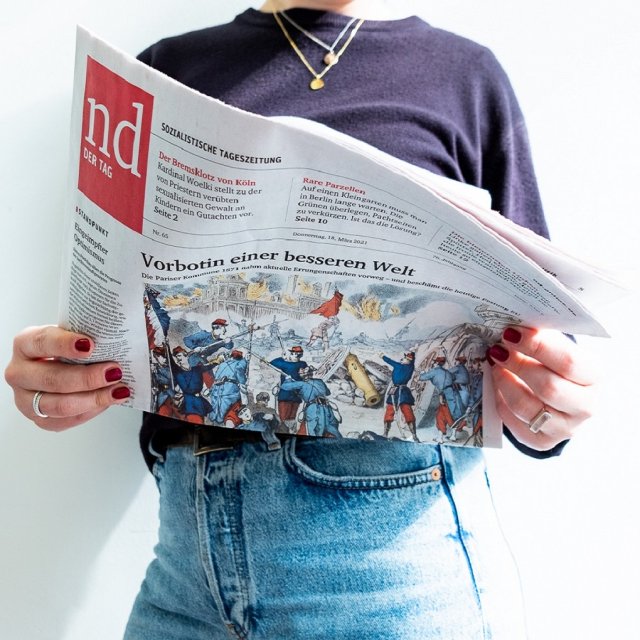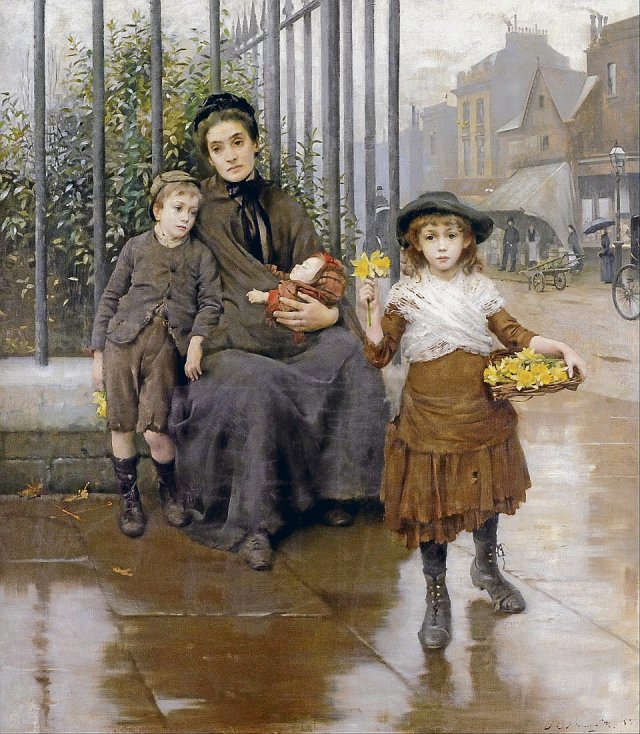Thomas Benjamin Kennington (1856–1916): »The Pinch of Poverty«, 1891
Foto: Foundling Museum
Museyroom
The power lies in the museum. Do not you believe? Come on in! Every month we present one, in text and pictures. Just as James Joyce wrote in “Finnegans Wake”: “This is the way to the museum room.”
On March 25, 1741, a four or five week old boy was dropped off at a temporary London children’s home: “Go gentle, babe.” He was marked “IA,” a diaper, and wrapped in a brown coat. He was given the number 5 and the name John Bowles. On April 13, 1741 he was entrusted to foster parents in the country. On May 24, 1746, he returned to London to the now established “Hospital for the Maintenance and Reduction of Exposed and Deserted Young Children,” which became known as the Foundling Hospital and existed until 1954. Anyone who knows the works of Charles Dickens will be familiar with the names.
With little John, 29 other small children were taken into the home. Only six children, two girls and four boys, remained alive and were supposed to go on an “apprenticeship.” John was the first of these residential students to become an “apprentice” at Bourne Place in Barham, Kent, in 1751; whether for the profession of gardener or servant is uncertain.
In July 1765, eight-year-old Mozart stayed there with his family. It is not known whether John’s working regime in Kent was tamer than that in a factory. Friedrich Engels wrote about the “apprentices” in “The Condition of the Working Class in England”: “From the beginning of the new industry, children were employed in the factories; initially because of the small size of the machines – which were later enlarged – almost exclusively, and the children were taken from the poorhouses, who were hired out in droves as ‘apprentices’ to the manufacturers for longer years. They were lodged and clothed in common and were of course the complete slaves of their brothers, who treated them with the greatest ruthlessness and barbarity.”
On August 9, 1800, baby number 18,607 was christened John Brownlow in the London home. He was supposed to defend the Foundling Hospital against critics and published the novel “Hans Sloane: A Tale illustrating the History of the Foundling Hospital” in 1831. The mastermind of the Foundling Hospital was the sailor Thomas Coram (ca. 1668–1751). When he returned from America, he was horrified by the poverty he found in London. This was the main reason why an estimated 1,000 babies were abandoned on the streets of London every year. Even 100 years later, Engels would write that night after night in London’s most brilliant district, “women can be found, women – young in years, old in sins and suffering, outcasts of society, rotting in hunger, filth and disease.” In addition to the reasons for poverty, there were also moral reasons – children born out of wedlock were also abandoned.
Coram spent 17 years collecting signatures from philanthropic and wealthy Londoners until King George II finally granted him a Royal Charter in October 1739 to establish the private charitable institution to take in foundlings and orphans, as well as children raised by them mother or her parents could not be cared for.
The Foundling Museum is dedicated to the history of the Foundling Hospital. This is also a place of remembrance of the painter William Hogarth (1697–1764) and the German composer Georg Friedrich Handel (1685–1759), both of whom were among the early supporters of Coram’s project. However, both also acted in their own interests. Hogarth sought to help English art gain recognition against the English preference for Italian and French art. The donation of his 1740 portrait of Coram established the Foundling art collection and encouraged his colleagues to also donate works to the hospital.
The Foundling Hospital became the first art address in London in the late 18th century. The Picture Gallery of the former Foundling Hospital has been reconstructed in the museum. In addition to Hogarth’s Coram portrait, works by Allan Ramsay, Thomas Hudson, Joseph Highmore, Francis Cote and Joshua Reynolds, among others, can be seen here. In the Court Room, which has also been reconstructed, in addition to eight round paintings from London hospitals, there are four large-format paintings dedicated to the rescue of children, such as Francis Hayman’s work “The Finding of the Infant Moses in the Bullrushes” from 1746.
Since an opera performance was expensive, Handel turned to composing oratorios in England, thereby laying the foundation for the English choral tradition. He also founded the tradition of performing his oratorio “Messiah” once a year at the Foundling Hospital. The crowd was always large and was very beneficial to his fame, his wallet and the proceeds for the hospital. While the premiere of “Messiah” in Dublin in 1742 was a great success, the first English performance in the Covent Garden Theater was heavily criticized – a religious work should not be presented by actresses in a theater. However, the oratorio became very popular with the performances at the Foundling Hospital.
The second floor of the museum is dedicated to Handel. Here you can see not only his handwritten last will (of which there are several versions), in which he also mentioned the Foundling Museum, but also materials for “Messiah” and the sheet music for conducting his “Foundling Hospital Anthem”. The Handel collection of Gerald Coke (1907–1990), which includes 10,000 objects and is used for research, is also located here.
On the ground floor of the Foundling Museum, the lives of the children in the charitable institution are highlighted. In the first 15 years after it was established, only around half of the children admitted survived. In comparison, the infant mortality rate of foundlings in the normal poorhouses and workhouses was almost 99 percent. When Parliament decreed that all infants brought into the home must be admitted, and as a result the capacity of the Foundling Hospital was exhausted, the number of deaths increased dramatically: around 15,000 children died in three years than 10,000. Parliament then withdrew its edition.
The recording system has been changed several times. There were so-called tokens for later, secure identification of the children. The mothers who could write left a piece of paper with information about their child. The “tokens” also included pieces of fabric (one for the home, one for the mother), a specially marked coin or medal. A girl taken in 1759 who was given the name Mary Russell wore an Irish halfpenny with eight notches on the edge on a string around her neck. The three-week-old girl, taken in in 1758 and given the name Ann Ketelby, was identified by a medal with the inscription “Maria Augusta Handel.”
The educational methods of the Foundling Hospital are explained on a blackboard. Coram’s goal was to educate the protégés into “useful citizens” and to prepare them for their future “serving or working existence.” They learned to read to study the Bible. Girls were encouraged to weave or knit, while boys braided rope or “went on military marches.” Later, the children were also taught to write, and there were mathematics and geography lessons as well as music lessons. Many of the boys joined the military through a music band by their parents, while the girls later had to work as maids. There had to be so much philanthropy.
Art still plays an important role in the foundling cosmos today. Works by female artists (including Ida Applebrog, Louise Bourgeois, Marlene Dumas, Maria Lassnig) from the Ursula Hauser collection are currently on display in the museum context (until February 18, 2024) under the title “The Mother & The Weaver”, dedicated to the vulnerability of children, their mothers and compassion.
Foundling Museum, 40 Brunswick Square, London WC1N 1AZ
www.foundlingmuseum.org.uk
Become a member of the nd.Genossenschaft!

Since January 1, 2022, the »nd« will be published as an independent left-wing newspaper owned by the staff and readers. Be there and support media diversity and visible left-wing positions as a cooperative member. Fill out the membership form now.
More information on www.dasnd.de/genossenschaft
sbobet88 judi bola sbobet sbobet88
